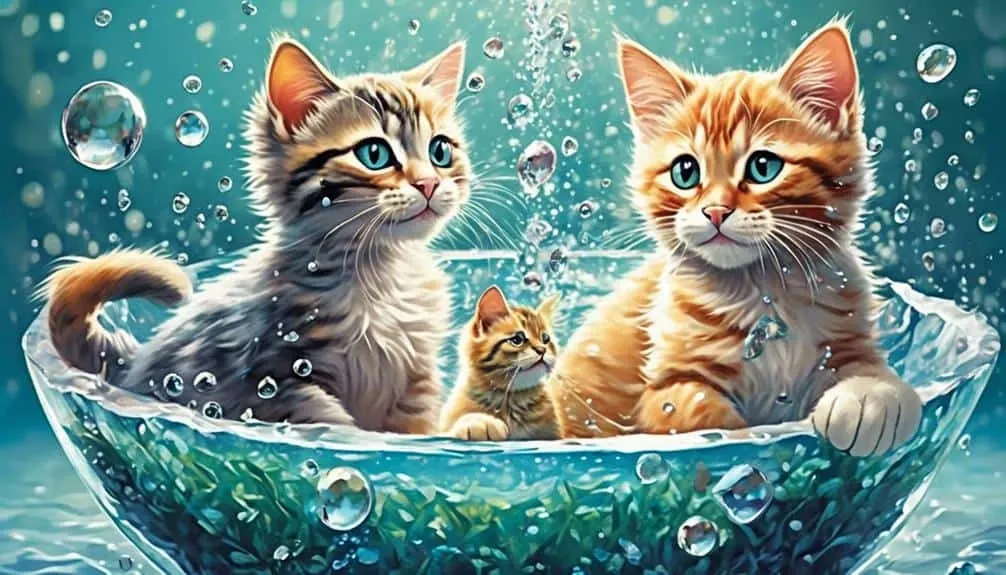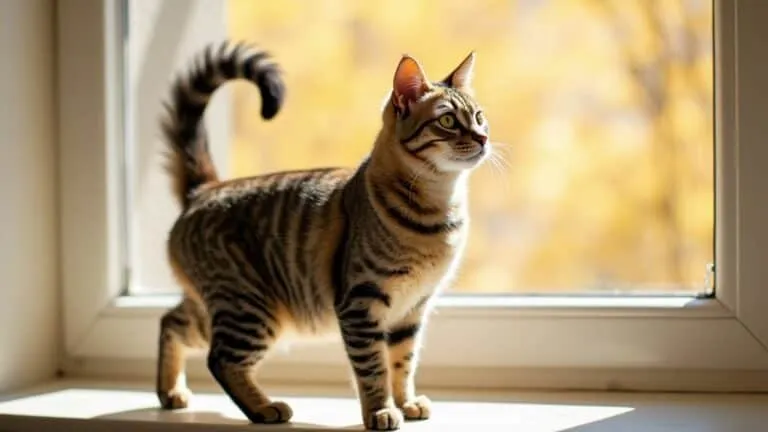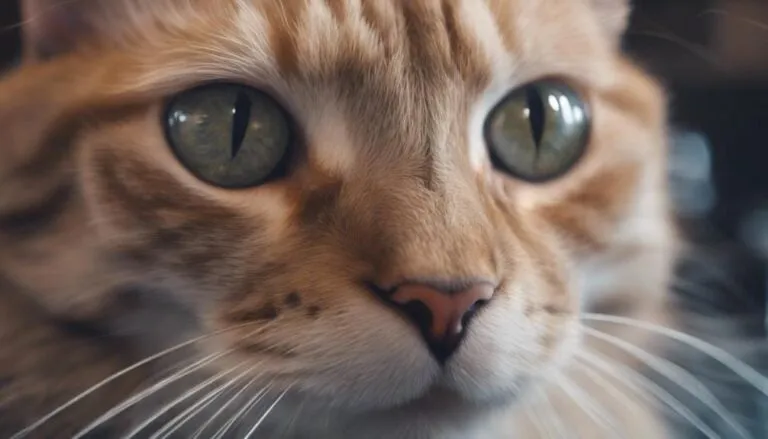The Best Fluffy Pancakes recipe you will fall in love with. Full of tips and tricks to help you make the best pancakes.

Have you ever wondered why cats are like little liquid acrobats around their water bowls? It's as if they're performing a synchronized water ballet, splashing and playing with a seemingly endless supply of energy. But what exactly prompts this curious behavior?
Well, get ready to dive into the fascinating world of feline water antics, because there's more to it than meets the eye. From their innate love for exploration to potential sensory sensitivities, we're about to unravel the intriguing reasons behind cats' playful splashing.
So, buckle up and prepare to be amazed by the surprising secrets of your curious cat's water bowl adventures.
Key Takeaways
- Cats may paw at the water bowl out of curiosity and to entertain themselves with the reflections and ripples.
- Whisker discomfort can be a reason for pawing behavior, as cats may try to avoid putting pressure on their whiskers while drinking.
- Pawing around the water dish can be a sign of compulsive behavior or obsessive-compulsive disorder in cats.
- Territorial instincts may also play a role in pawing behavior, as cats may mark their ownership and discourage other cats from drinking from their water bowl.
Reasons for Pawing Behavior
Cats engage in pawing behavior around their water bowl for various reasons. This behavior can include seeking entertainment, addressing whisker discomfort, exhibiting compulsive tendencies, or expressing their territorial instinct.
Pawing around the water bowl may be a sign of boredom or a habit developed for entertainment. Cats are attracted to shiny and reflective objects, and water's reflective property can be a source of entertainment for them. Pawing at the water creates ripples and allows them to enjoy the reflections.
Additionally, some cats prefer drinking from a water bowl and may paw at the water as part of their drinking ritual. To discourage excessive pawing behavior, you can observe your cat's drinking habits and identify any triggers for pawing. Providing filtered water and multiple water dishes can also help redirect their playful behavior.
If whisker discomfort is suspected, specialized bowls designed to alleviate discomfort can be used.
Whisker Discomfort
To address the issue of whisker discomfort in cats, it's important to consider how their sensitive whiskers can be affected by the size and shape of their water bowls.
Whisker fatigue, also known as tactile defensiveness, can occur when a cat's whiskers constantly touch the sides of a narrow water bowl. This can cause discomfort and stress for the cat.
Cats with whisker fatigue may exhibit pawing behavior around the water bowl, as they try to avoid putting pressure on their whiskers.
To alleviate whisker discomfort, it's recommended to provide cats with wider and shallower water bowls that allow their whiskers to remain free and unencumbered.
Compulsive Behavior
Excessive scratching or pawing around the water dish may indicate compulsive behavior in cats. Compulsive behaviors in cats, such as repetitive and exaggerated pawing, can be signs of obsessive-compulsive disorder (OCD). These behaviors seem to serve no purpose and can be distressing for both the cat and the owner.
Stress or dislike for the water's taste may contribute to OCD-like behaviors. To address this issue, it's important to maintain fresh and clean water to reduce stress-related pawing behavior. Additionally, providing filtered water and placing the water bowl away from food sources, litter box, and busy areas can help alleviate the compulsive behavior.
If efforts to address the pawing behavior are unsuccessful, it's advisable to consult a veterinarian for further treatment options and to rule out any underlying health issues.
Territorial Instinct
Pawing around the water dish can be a way for your feline friend to assert their ownership and mark their territory. Cats have a strong territorial instinct, and they use their paws to claim their space. Here are three reasons why cats exhibit this behavior:
- Territorial marking: Cats have scent glands on their paws, and scratching or pawing around the water dish is a way for them to leave their scent and communicate to other cats that this area is already claimed.
- Outdoor cat behavior: Outdoor cats may encounter other cats in their territory, and pawing around the water dish is a way for them to establish boundaries and prevent other cats from encroaching on their territory.
- Multiple cats in the household: When there are multiple cats in the household, each cat may try to assert their ownership by pawing around the water dish. This behavior helps them establish their hierarchy and maintain their sense of security.
Understanding your cat's territorial instincts can help you create a peaceful environment for them. Providing separate water dishes and ensuring a quiet drinking spot can alleviate territorial insecurity and promote harmony among your feline companions.
Observing Drinking Habits
As you watch your cat pawing around the water dish, you may notice certain patterns and behaviors that can provide insight into their drinking habits. Conducting a water bowl analysis can help you understand your cat's hydration patterns better.
Observe how often your cat visits the water bowl and the amount of water they consume each time. Keep track of any changes in their drinking habits, such as increased or decreased water intake.
Note if they prefer pawing at the water before drinking or if they drink directly from the bowl.
Analyzing these observations can help you ensure your cat stays properly hydrated and identify any potential issues with their drinking habits.
Providing Filtered Water
To ensure your cat's optimal hydration, consider providing filtered water for them. Here are the benefits of using filtered water:
- Improved taste and smell: Filtered water removes impurities such as chlorine and minerals, resulting in a cleaner and more appealing taste for your cat. This can encourage them to drink more and stay hydrated.
- Healthier hydration: Filtering water can help remove harmful bacteria, viruses, and contaminants, ensuring that your cat's water is safe and clean to drink. This can contribute to their overall health and well-being.
- Reduces potential health issues: By using filtered water, you can minimize the risk of your cat ingesting harmful substances that may be present in tap water. This can help prevent digestive issues and other health problems.
While filtered water offers these benefits, alternatives such as bottled water or tap water can also be used. However, it's important to note that tap water may contain chemicals and contaminants that could be detrimental to your cat's health.
Providing filtered water is a proactive step towards ensuring your cat's hydration and promoting their overall health.
Multiple Water Dishes
Are multiple water dishes beneficial for cats?
Observing cats around water bowls, it's evident that having multiple water dishes can be advantageous. Cats often splash and play around their water bowls, leading to spills and wet floors. By providing multiple water dishes, you can prevent water spills and keep your surroundings dry.
Strategically placing water bowls in different areas of your home can encourage cats to drink more and stay hydrated. Additionally, having multiple water dishes can help avoid territorial disputes among multiple cats in the household. It also ensures that each cat has easy access to water without having to compete with others.
Engaging in Interactive Games
Multiple water dishes can't only prevent spills and wet floors but also provide opportunities for engaging in interactive games with your curious cat. Playtime activities are essential for keeping your cat mentally stimulated and physically active. Here are three interactive toys that can turn your cat's drinking time into a fun and engaging experience:
- Puzzle Feeders: These toys require your cat to work for their food or treats. By placing a puzzle feeder near their water bowl, your cat can engage in a stimulating activity while hydrating. This helps prevent boredom and encourages natural foraging behavior.
- Water Fountain with Floating Toys: A water fountain with floating toys can grab your cat's attention and make drinking more exciting. The movement of the water and the floating toys can entice your cat to play and stay hydrated at the same time.
- Laser Pointers: Laser pointers are a classic interactive toy that can keep your cat entertained for hours. Shine the laser around the water bowl area to encourage your cat to chase and pounce on the moving light. This not only adds excitement to their playtime but can also encourage them to drink more water.
Specialized Bowls and Water Fountains
One effective way to address pawing behavior in cats is by using specialized bowls and water fountains. These can provide several benefits for your feline friend.
Specialized bowls, such as stainless steel bowls with mats, can alleviate whisker discomfort by providing a wider and more comfortable drinking surface. They also help prevent spills and protect surfaces from scratching and pawing damage.
Water fountains, on the other hand, offer a more interactive and entertaining drinking experience for cats. They provide a constant flow of fresh, filtered water, which can entice cats to drink more and stay hydrated.
When comparing different types of water fountains, consider factors like ease of cleaning, noise level, and water capacity.
Conclusion
In conclusion, understanding why cats splash and play around their water bowls can help us better meet their needs and promote their overall well-being.
Just like a child splashing in a pool on a hot summer day, cats find joy and entertainment in this behavior.
By providing filtered water, multiple water dishes, and engaging in interactive games, we can ensure our feline friends stay hydrated and satisfied.
So let's embrace their playful nature and make their water time a fun and enriching experience!








